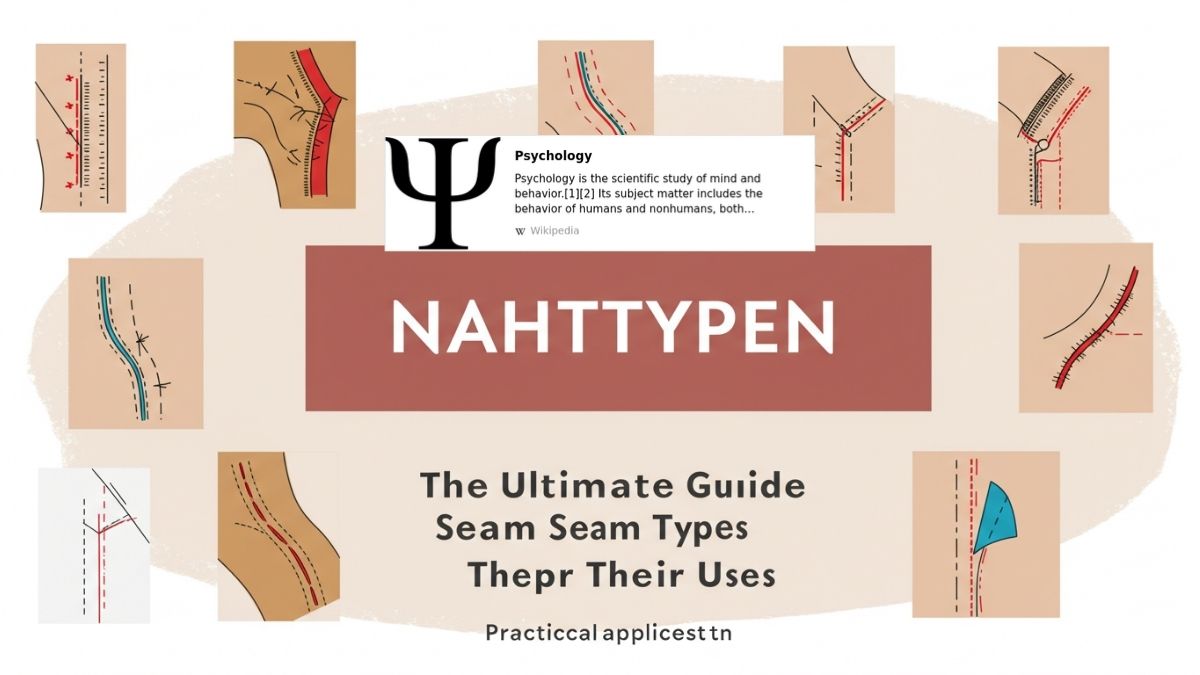In the world of sewing, the term nahttypen refers to the various types of seams used to join fabrics. Seam types are the foundation of garment construction, home textiles, and craft projects. Choosing the correct nahttypen is essential for creating durable, functional, and visually appealing pieces.
From basic seams suitable for everyday clothing to complex seams for heavy-duty materials, each nahttypens serves a distinct purpose. Understanding these types allows sewers and designers to achieve professional results while ensuring longevity and aesthetic appeal.
Why Nahttypen Matter in Sewing
The type of seam used in a project impacts several important factors:
-
Durability: Some nahttypen can withstand stress better, making them ideal for activewear, jeans, or work uniforms.
-
Flexibility: Stretchable fabrics require seam types that accommodate movement without breaking.
-
Appearance: Certain seams are decorative and can enhance the overall design of a garment.
-
Fabric Compatibility: Not all seams are suitable for every fabric. Proper knowledge of nahttypens helps in selecting the right seam for the right material.
Without understanding nahttypens, even experienced sewers can end up with weak or unattractive finishes.
Common Types of Nahttypens
There are numerous nahttypen used in sewing. Here’s a detailed look at the most widely applied seams:
1. Plain Seam (Einfachnaht)
The plain seam is the simplest and most common nahttypen. It involves stitching two fabric pieces together and finishing the raw edges to prevent fraying. This seam is versatile and ideal for lightweight fabrics like cotton, linen, or polyester blends.
Applications: Everyday clothing, curtains, and basic sewing projects.
2. French Seam (Französische Naht)
The French seam is perfect for delicate or sheer fabrics. It encloses the raw edges within a second seam, giving a polished look on both sides.
Advantages:
-
Provides a clean finish
-
Prevents fraying
-
Adds strength to lightweight fabrics
Applications: Silks, chiffons, fine dresses, and blouses.
3. Flat-Felled Seam (Doppeltgelegte Naht)
Flat-felled seams are renowned for their strength and durability. They involve folding the fabric edges inward and stitching them down, creating a flat, reinforced seam.
Benefits:
-
Extremely durable
-
Professional finish
-
Suitable for high-stress garments
Applications: Jeans, shirts, workwear, and outdoor clothing.
4. Overlocked Seam (Overlock-Naht)
The overlocked seam is achieved using a serger or overlock machine. It trims the fabric edge while stitching, preventing fraying and providing stretchability.
Applications: Knitwear, activewear, and home textiles requiring flexibility.
5. Topstitched Seam (Ziernähte)
Topstitched seams are both functional and decorative. The stitching is visible on the outside of the fabric, adding style while reinforcing the seam.
Best for: Jackets, bags, denim, and decorative accents on garments.
6. Bound Seam (Gebundene Naht)
In a bound seam, raw edges are enclosed with a fabric strip or bias tape. This seam type is particularly effective for lightweight fabrics and adds both protection and decoration.
Applications: Lingerie, blouses, and delicate apparel.
Factors to Consider When Choosing Nahttypen
Selecting the correct nahttypen is crucial. Here are key considerations:
1. Fabric Type
Lightweight, stretch, or delicate fabrics require specific seams to prevent damage and maintain flexibility.
2. Project Purpose
Activewear and workwear benefit from reinforced seams like flat-felled seams, while casual clothing may only require basic plain seams.
3. Aesthetic Value
Some seams are decorative and can enhance the overall design, while others are purely functional. Topstitched or bound seams can elevate the visual appeal of garments.
4. Skill Level
Certain nahttypen, like French seams or bound seams, require advanced skills. Beginners may find plain or overlocked seams easier to manage.
Expert Tips for Working with Nahttypen
Mastering different seam types can significantly improve your sewing quality. Here are practical tips:
-
Use Proper Tools: Invest in quality sewing machines, needles, and threads suitable for your fabric type.
-
Practice on Scrap Fabric: Always test your seam type on a small fabric piece before starting your main project.
-
Press Seams Correctly: Ironing your seams ensures a smooth, professional finish.
-
Finish Raw Edges: Techniques like zigzag stitching, overlocking, or pinking shears prevent fraying.
-
Follow Fabric Grain: Aligning seams with the fabric grain ensures stability and proper drape.
Advanced Nahttypen for Specialized Projects
Professional sewers often use advanced nahttypen to enhance durability and aesthetics:
-
Hong Kong Seam: Encloses raw edges with bias tape for a refined finish.
-
Mock Flat-Felled Seam: Provides strength similar to flat-felled seams with less complexity.
-
Lapped Seam: Overlaps edges and stitches them for strong, professional outerwear seams.
Incorporating these advanced seam types can elevate both the quality and appearance of garments.
Common Mistakes to Avoid with Nahttypen
Even experienced sewers can make mistakes with seams. Here’s how to avoid common pitfalls:
-
Incorrect Seam Allowance: Measure and maintain consistent seam allowances.
-
Ignoring Fabric Stretch: Using a rigid seam for stretch fabrics can result in seam failure.
-
Skipping Edge Finishing: Unfinished edges fray and weaken the seam.
-
Neglecting Pressing: Poorly pressed seams look bulky and unprofessional.
By paying attention to these details, your projects will be durable, neat, and visually appealing.
Conclusion
Understanding nahttypen is essential for anyone involved in sewing, from beginners to professionals. Each seam type has unique characteristics, applications, and benefits. By choosing the right nahttypen, you can enhance durability, improve flexibility, and elevate the aesthetic value of your creations.
Experimenting with both basic and advanced seam types allows sewers to achieve professional results while tailoring garments to their specific needs. Knowledge of nahttypens is the key to creating high-quality, long-lasting, and beautifully finished sewing projects.
